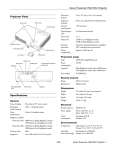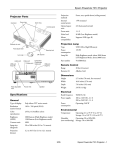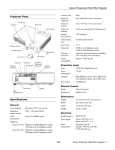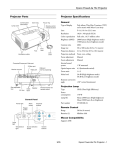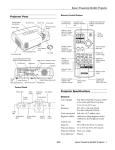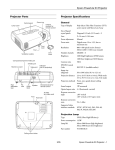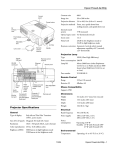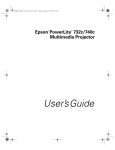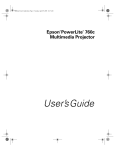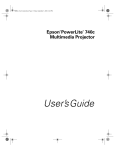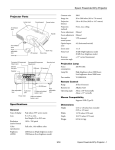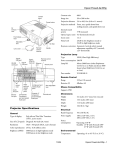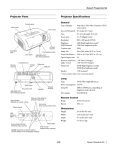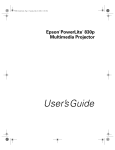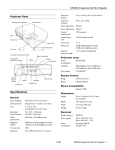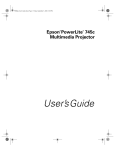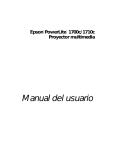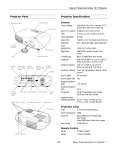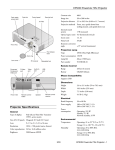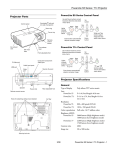Download Epson 740c - PowerLite XGA LCD Projector Specifications
Transcript
Epson PowerLite 740c Projector Projector Parts Zoom ring Focus ring Control panel Projection methods Front, rear, upside-down (ceiling mount) Internal sound system 1 W monaural Optical aspect ratio 4:3 (horizontal:vertical) Zoom ratio 1:1.2 Noise level 36 dB (Low Brightness mode) Mouse compatibility Supports USB (type B) Projection Lamp Exhaust air vent Foot adjust lever Security lock I/R receiver Lens cap Video port Audio port S-Video port USB port Computer/Component Video port Type UHE (Ultra High Efficiency) Power consumption 170 W Lamp life High Brightness mode: about 2000 hours Low Brightness Mode: about 3000 hours Part number V13H010L32 Remote Control Range 20 feet (6 meters) Batteries (2) Alkaline AAA Dimensions Rear adjustable foot Power inlet Speaker Height 2.7 inches (70 mm), feet retracted Width 10.9 inches (276 mm) Depth 7.6 inches (193 mm) Weight 3.8 lb (1.7 kg) Electrical Specifications Rated frequency 50/60 Hz AC Power supply 100 to 120 VAC, 2.7 A 200 to 240 VAC, 1.1 A Power consumption Operating: 240 W General Type of display Poly-silicon TFT active matrix Resolution (native format) 1024 × 768 pixels (XGA) Color reproduction 24-bit, 16.8 million colors Brightness (ANSI) 2500 lumens (High Brightness mode) 2000 lumens (Low Brightness mode) Contrast ratio 400:1 Image size 30 to 300 inches (0.8 to 7.6 meters) Projection distance 3.2 to 39.7 feet (1.0 to 12.1 meters) Environmental 8/04 Temperature Operating: 41 to 95 °F (5 to 35 °C) Storage: 14 to 140 °F (–10 to 60 °C) Humidity (non-condensing) Operating: 20 to 80% RH Storage: 10 to 90% RH Epson PowerLite 740c Projector - 1 Epson PowerLite 740c Projector Safety and Approvals United States FCC 47CFR Part15B Class B (DoC) UL60950 Third Edition Canada ICES-003 Class B CSA C22.2 No. 60950 CE Marking Directive 73/23/EEC, 89/336/EEC IEC60950 Third Edition EN 55022, EN 55024 Compatible Video Formats The projector supports the video display formats listed below: Mode Refresh Rate (Hz) NTSC NTSC 4:43 PAL N—PAL M—PAL PAL—60 SECAM 60 60 50 50 60 60 50 HDTV (720p) HDTV (720p) HDTV (1080i) HDTV (1080i) SDTV (480i) SDTV (480i) TV480i TV480i 60 50 60 50 60 50 60 50 Compatible Computer Display Formats To project images from a computer, set the computer’s video card at a refresh rate (vertical frequency) compatible with the projector; see the following table for compatible formats. Some images are automatically resized to display in the projector’s native format (XGA). The frequencies of some computers may not allow images to display correctly; see your computer’s documentation for details. 2 - Epson PowerLite 740c Projector Mode Refresh Rate (Hz) Resolution VGA EGA VGA—60 VESA—72 VESA—75 VESA—85 70 60 72 75 85 640 × 350* 640 × 480* 640 × 480* 640 × 480* 640 × 480* SVGA—56 SVGA—60 SVGA—72 SVGA—75 SVGA—85 56 60 72 75 85 800 × 600* 800 × 600* 800 × 600* 800 × 600* 800 × 600* XGA—60 XGA—70 XGA—75 XGA—85 60 70 75 85 1024 × 768 1024 × 768 1024 × 768 1024 × 768 SXGA1—70 SXGA1—75 SXGA1—85 70 75 85 1152 × 864* 1152 × 864* 1152 × 864* SXGA2—60 SXGA2—75 SXGA2—85 60 75 85 1280 × 960* 1280 × 960* 1280 × 960* SXGA+60 SXGA+75 SXGA+85 60 75 85 1400 × 1050* 1400 × 1050* 1400 × 1050* SXGA3—60 SXGA3—75 SXGA3—85 60 75 85 1280 × 1024* 1280 × 1024* 1280 × 1024* UXGA—60 60 1600 × 1200* iMAC VGA iMAC SVGA iMAC XGA MAC13 MAC16 MAC19—60 MAC19 MAC21 117 95 75 67 75 59 75 75 640 × 480* 800 × 600* 1024 × 768 640 × 480* 832 × 624* 1024 × 768 1024 × 768 1152 × 870* *The image is resized using Epson’s SizeWise™ Technology. 8/04 Epson PowerLite 740c Projector If you place the projector below the level of the screen, you’ll have to tilt it up by extending the front adjustable foot, as shown. Tilting the projector upward causes the image to lose its rectangular shape, but you can correct the distortion by pressing the Sync buttons on the projector. See page 6 for detailed information about correcting the image shape. Positioning the Projector Before connecting the projector, you need to decide where to place it. The location you choose depends on the size of the room and what you are projecting. ❏ Place the projector on a sturdy, level surface, between 3.2 and 39.7 feet from the screen. ❏ Make sure there is plenty of space for ventilation around and under the projector. Do not set the projector on top of anything that could block the vents under the projector. ❏ Make sure the projector is within 10 feet of an electrical outlet or extension cord and within 5 feet of your computer and/or video source. ❏ Place the projector directly in front of the center of the screen, facing the screen squarely. Otherwise, your image will not be rectangular. If you place the projector level with the bottom of the screen, the image will be rectangular and you won’t have to adjust it. If you place the projector higher than the bottom of the screen, the image will still be rectangular, but you won’t be able to fill the whole screen with the image. Note: It’s easier to position the projector when the screen is directly in front of the room. If the screen is placed diagonally in a corner, it’s much more difficult to aim the projector correctly at the screen and get a rectangular image. Use the figure below as a guideline to help you determine how far from the screen to place the projector. Image size generally increases with distance, but may vary depending on how you position the zoom ring and whether you have adjusted the image size with other settings. Starting Up the Projector Make sure your projector and other equipment are set up and connected correctly. Then turn on your projector, as described below. If you turn on your connected computer or video equipment before starting the projector, the projector automatically detects and displays the image source. If you turn on the projector first, or have multiple pieces of connected equipment, you may have to select the image source manually. See “Selecting the Image Source” on page 5. 33.1 to 39.7 feet Follow these steps to plug in and turn on the projector: 6.6 to 7.9 feet 3.2 to 3.9 feet 1. Remove the lens cap. To calculate exact measurements, use the following formulas: Caution Do not use the projector with the lens cap in place. The heat generated by the lamp can damage the cap. ❏ To find the projection distance when you know the screen’s diagonal dimension: Wide (inches) = ((33.696 × diagonal screen size [inches]) – 21.717) / 25.4 Tele (inches) = ((40.453 × diagonal screen size [inches]) – 22.52) / 25.4 2. Connect one end of the power cord to the projector’s power inlet. Then connect the other end to an electrical outlet. The P Power light on top of the projector turns orange, indicating that the projector is receiving power but not yet turned on. Wait until the light stops flashing, but stays lit orange. ❏ To find how large a screen’s diagonal dimension will be when you know the projection distance: Wide (inches) = (Projection distance [inches] × 0.254 + 0.02171 / 0.033696 Tele (inches) = (Projection distance [inches] × 0.0254 + 0.02252) / 0.040453 8/04 Epson PowerLite 740c Projector - 3 Epson PowerLite 740c Projector What To Do If You See a Blank Screen 3. Press the P Power button on top of the projector or on the remote control. If you see a blank screen or the No Signal message after turning on your computer or video source, try the following: Power button ❏ Make sure the cables are connected correctly. ❏ Make sure the P Power light is green and not flashing and the lens cover is off. ❏ Press the Source Search button on the projector or the Search button on the remote control repeatedly until you see the image you want to project. See page 5 for more information about selecting the image source. Projector Remote control If you’re using a Windows computer: The projector beeps once and the P Power light flashes green as the projector warms up, then an image begins to appear. When the P Power light stops flashing and remains green, the projector is ready for use. ❏ Hold down the Fn key and press the function key that lets you display on an external monitor. It may have an icon such as or it may be labelled CRT/LCD. Allow a few seconds for the projector to sync up after pressing it. Check your computer’s manual or online help for details. Warning: Never look into the lens when the lamp is on. This can damage your eyes, and is especially dangerous for children. On most systems, the or CRT/LCD key lets you toggle between the LCD screen and the projector, or display on both at the same time. ❏ If you’ve connected a Windows®-based computer to the projector, you may see a New Hardware Wizard saying your computer has found a plug-and-play monitor; if so, click Cancel. ❏ Depending on your computer’s video card, you might need to use the Display utility in the Control Panel to make sure that both the LCD screen and external monitor port are enabled. See your computer’s documentation or online help for details. ❏ If you don’t see the image you want, press the Source Search button on the projector or the Search button on the remote control until you see the image you want to project. If you’re using a Macintosh® with OS X: You may need to set up your system to display on the projector screen as well as the LCD screen. Follow these steps: ❏ If you are prompted to enter a password, see “Starting the Projector with a Password” on page 10. 1. From the Apple menu, select System Preferences, then click Displays. Note: You can also use the Source buttons on the remote control to switch between devices connected to the ports identified on each button. For details, see page 5. 2. Select VGA Display or Color LCD, click Arrange or Arrangement, and make sure Mirror Displays is checked. If you’re using a Macintosh with OS 8.6 to 9.x: If a projected image fails to appear, see “What To Do If You See a Blank Screen” in the next column. You may need to set up your system to display on the projector screen as well as the LCD screen. Follow these steps: When you’re done with your presentation, shut down the projector as described on page 7. Shutting down the projector correctly prevents premature lamp failure and possible damage from overheating. 1. From the Apple menu, select Control Panels, then click Monitors or Monitors and Sound. 2. Click the Arrange icon. 3. Drag one monitor icon on top of the other. If the Arrange option isn’t available, try selecting one of the Simulscan resolution settings. Click the Monitor icon, if necessary, and then select a Simulscan resolution. (Allow a few seconds for the projector to sync up after making the selection.) 4 - Epson PowerLite 740c Projector 8/04 Epson PowerLite 740c Projector You can also change the image size by moving the projector closer to or farther away from the screen. You can use the E-Zoom buttons on the remote control to zoom in on a portion of the image. See “Zooming Your Image” on page 8 for instructions. Selecting the Image Source If multiple devices are connected to the projector, the easiest way to select the image source is to press the Search button on the remote control or the Source Search button on the projector until the correct image is projected. Adjusting the Height of Your Image You can also press one of the following buttons on the remote control: If the image is too low, you can raise it by extending the projector’s front adjustable foot. ❏ Computer to select the device connected to the projector’s Computer/Component Video port. 1. Stand behind the projector. Press up on the blue foot release lever and lift the front of the projector to extend the front adjustable foot. ❏ S-Video to select the device connected to the S-Video port. ❏ Video button to select the device connected to the Video port. After you select a source, the screen goes dark for a moment before the image appears. Note: The PowerLite740c does not support the EasyMP button. Adjusting the Image 2. Once the image is positioned where you want it, release the lever to lock the foot in position. Once you see your image, you may need to make certain adjustments, as described in this section. 3. If the projector isn’t level, rotate the back foot on the back of the projector. Focusing and Zooming Your Image Rotate the focus ring to sharpen the image. If the image is no longer rectangular after raising it, see the next section. Focus ring Rotate the zoom ring to reduce or enlarge the image. Zoom ring 8/04 Epson PowerLite 740c Projector - 5 Epson PowerLite 740c Projector Adjusting the Image Shape Adjusting the Color Mode The projector automatically corrects images that are distorted when the projector is tilted up or down (up to a 15° tilt). The Keystone window appears on the screen while the projector makes the correction. If the projected image still isn’t rectangular or has a “keystone” shape, do one or more of the following: You may want to adjust the color mode to select a setting that is appropriate for the image you’re projecting and the environment in which you’re projecting it. The following table lists the available color modes. ❏ If your image looks like or , you’ve placed the projector off to one side of the screen, at an angle. Move it directly in front of the center of the screen, facing the screen squarely. ❏ If your image looks like or , you may need to manually adjust the keystone correction value. Follow the directions below: ❏ To make keystone corrections using the projector’s Setting menu, press the Menu button on the projector or remote control. Select the Setting menu, then press Enter. Select Keystone and press Enter. Use the pointer button on the remote control (or the arrow buttons on the projector) to adjust the keystone setting as needed. ❏ To manually adjust the keystone correction value, press the or button on the projector to correct the shape of the image. After correction, your image will be slightly smaller. Color mode Description sRGB For matching the color palette of standard sRGB computer displays. Dynamic For increased brightness in bright rooms (the default for non-computer display). Presentation For computer presentations (the default when projecting from a computer with analog video). Theater For optimizing movie images with increased contrast. Living Room For increased brightness when playing video games or watching TV in a bright room. Blackboard For projecting accurate colors on a green chalkboard (adjusts the white point). To change the color mode, press the Color Mode button on the remote control until you see the mode you want. The currently selected setting appears in the upper right corner of the screen. You can also use the projector menu system to select the Color Mode in the Image menu. Correcting Computer Images If you’ve connected a computer and the image doesn’t look right, or it doesn’t fit properly on the screen, press the Auto button on the remote control. This automatically resets the projector’s tracking, sync, resolution, and position settings. You must be projecting an image for this button to have any effect. Additionally, if the Auto Setup option in the Signal menu is set to OFF, the Auto function will not work. Adjusting the Brightness The brightness of an image depends on the source you are projecting and the amount of light in the room. If the image is too bright or not bright enough, do one of the following: ❏ Change the Brightness setting in the Image menu. ❏ Select Low or High for the Brightness Control option in the Setting menu. Low Brightness mode extends the life of the lamp and decreases the fan noise. 6 - Epson PowerLite 740c Projector 8/04 Epson PowerLite 740c Projector 4. Press up on the blue foot release lever and lower the projector to retract the front adjustable foot, as shown. Sleep Mode When the projector has not received any input signals for 30 minutes, it automatically turns off the projector lamp and enters “sleep mode.” This conserves electricity, cools the projector, and extends the life of the lamp. If you are done using the projector, unplug the power cord. If you want to start projecting again, press the P Power button. You can enable sleep mode in the Extended menu under Operation. Using Direct Power On 5. Replace the lens cap and unplug the power cord. Caution To avoid damaging the projector or lamp, never unplug the power cord when the P Power light is green or flashing orange. The Direct Power On function enables faster setup. The projector will start up automatically when you plug it in; you won’t have to press the P Power button. Follow these steps to enable Direct Power On: 1. Press the Menu button on the remote control and select the Extended menu. Using the Remote Control 2. Choose Operation and press Enter. Before using the remote control, insert the two AAA alkaline batteries, as described on your Quick Setup sheet. 3. Choose Direct Power On and press Enter. When using the remote control, stand within 20 feet of the projector. Point the remote control either at the projector or at the screen (the projector’s front sensor can detect signals bounced off the screen). Press the button for the function you want to use. 4. Highlight ON and press Enter. 5. Press Esc or Menu to exit. Note: When Direct Power On is enabled, shut down the projector as you normally would. Follow the instructions in the next section. (The projector will start automatically when power is restored after a power failure if it is plugged in.) Turning Off the Picture and Sound You can use the A/V Mute button on the remote control to turn off the image and sound and darken your screen. This is useful if you want to temporarily re-direct your audience’s attention. Shutting Down the Projector ❏ To turn off the picture and sound, press the A/V Mute button. The screen turns blue. When you’ve finished using the projector, follow the recommended procedure to shut it down. This extends the lamp life and protects the projector from possible overheating. ❏ To turn the image and sound back on, press the A/V Mute button again. You can create an image, such as a company logo or a picture, to display on the screen whenever you press the A/V Mute button. See the User’s Guide for more information. 1. Turn off any equipment plugged into the projector. 2. To turn off the projector, press the P Power button on the projector or remote control. You see a confirmation message. (If you don’t want to turn it off, press any other button.) Stopping Action Press the Freeze button to stop the action in your video or computer image and keep the current image on the screen. The sound will continue, however; and if you have connected an external monitor for simultaneous display, the action continues on the monitor even though it is paused on the screen. 3. Press the P Power button again. The P Power light flashes orange as the projector cools down. When the projector beeps twice, it’s safe to unplug it. To turn the projector on again, wait until the P Power light stops flashing. Then press the P Power button. To restart the action, press the Freeze button again or press Esc. 8/04 Epson PowerLite 740c Projector - 7 Epson PowerLite 740c Projector Zooming Your Image ❏ To double-click, press the Enter button twice. Follow these steps to zoom in on a portion of the image: ❏ To click and drag, press and hold the Enter button and use the pointer button to move the pointer, then release the Enter button. 1. Press the E-Zoom button on the remote control. You see a crosshair indicating the center of the zoom-in area. 2. Use the pointer button to position the crosshair in the area you want to enlarge. 3. Continue pressing the E-Zoom selected area up to 4 times. Replacing the Batteries Caution: When replacing batteries, take the following precautions: button to enlarge the ❏ Replace the batteries as soon as they run out. If a battery leaks, 4. While the image is enlarged, you can: ❏ Use the wipe away battery fluid with a soft cloth. If fluid gets on your hands, wash them immediately. pointer button to move around the screen. ❏ Press the E-Zoom ❏ Do not expose batteries to heat or flame. button to zoom out. ❏ Dispose of used batteries according to local regulations. 5. When you’re done, press the Esc button to return the image to its original size. ❏ Remove the batteries if you won’t be using the projector for a long time. Using the Remote Control as a Wireless Mouse Follow these steps to replace the AAA alkaline batteries: When you use the remote control as a wireless mouse, you can control your computer or click through slideshow-style presentations (such as PowerPoint®) from up to 20 feet away. To control your computer with the remote, make sure you have connected the USB mouse cable between the projector and your computer. Page up or page down 1. Press in the tab to remove the battery cover. Move the pointer 2. Remove the old batteries, then insert the new ones as shown. Left-click or double-click Right-click Display the pointer 3. Replace the battery cover. (It should snap into place.) ❏ To advance slides in a PowerPoint presentation in Slide Show mode, press the Page Up or Enter button on the remote control. Press the Page Down or Esc button to go back a slide. ❏ To display the mouse pointer, press the Pointer button. ❏ To move the pointer on the screen, aim the remote at the screen and use the pointer button. ❏ To click (or left-click), press the Enter button. ❏ To right-click, press the Esc button. 8 - Epson PowerLite 740c Projector 8/04 Epson PowerLite 740c Projector 6. Hold down the Num button on the remote control and use the numeric keypad to enter a 4-digit password. Using Password Protection If you assign a password for the projector, a screen appears requesting the password whenever you turn on the projector. If you enter the password incorrectly three times in succession, the projector’s operation is locked. Disconnect the projector and reconnect it. If you enter the incorrect password 30 times in a row, the projector is locked and remains locked until an authorized Epson servicer can unlock it. The password will be displayed as ****. After you enter the last digit, a confirmation screen appears. Enter the password again. 7. After you finish setting the password, press the Esc button to return to the Password Protect menu. You can also create a user’s logo for the projector, to be displayed as the startup screen and/or AV/Mute screen. Unauthorized users cannot turn it off or change it. This discourages theft and provides a way to identify the projector should it be stolen. Numeric keypad Num button Make a note of the password and keep it in a safe place in case you forget it. Additionally, to make sure a borrowed projector is returned, you can temporarily disable the password for a set period of time. When that time has elapsed, the password function is reactivated and you must enter the password before you can use the projector. Turning On the Password and User’s Logo To enable the password and User’s Logo, follow these steps: 1. Press the Freeze button on the remote control for about 5 seconds until you see the Password Protect menu. Follow the instructions below to set the password, and then turn on the password and/or user logo protection. 2. Select Power ON Protect and press Enter. Note: If you should happen to enable the password before you set one, and you see the prompt to enter the password, enter the default password 0000 to proceed. 3. Select ON and press Esc. 4. If you want to disable the password temporarily so someone can use the projector without entering the password, select Timer and press Enter. Then hold down the Num button while you use the numeric keypad to enter the number of hours (from 0 to 9999) you want the password feature disabled. If you want the projector to request the password every time it is turned on, set the timer to 0H. Setting a Password 1. Press the Freeze button on the remote control for about 5 seconds, until you see the Password Protect menu: The timer starts counting as soon as you close the Password Protect menu. (You can check the elapsed time in this menu next to Time elapsed.) When the period defined in the Time-elapsed setting has passed, and the password is entered correctly, the elapsed time will be reset to 0H and the timer will start again. Remember to disable or change this setting when you’re finished using it. 5. To enable your User’s Logo, select User’s Logo Protect and press Enter. Then select ON and press Enter. If a password has already been set, you see the Password Protect Release screen. See “Starting the Projector with a Password” on page 10. When this feature is on, the logo appears whenever the projector is turned on (if the Startup Screen is enabled in the Extended menu) and as the A/V Mute screen (if you selected Logo as the Background Color in the Extended menu). 2. Set Power ON Protect to ON and press Enter. 3. Press Esc. 4. Select Password and press Enter. You see the message Change the password? Note: None of the User’s Logo features can be changed when the User’s Logo Protect function is enabled. 5. Select Yes and press Enter. 6. Press Menu to close the Password Protect menu. 8/04 Epson PowerLite 740c Projector - 9 Epson PowerLite 740c Projector Starting the Projector with a Password Projector Status Lights Caution: If you lose the remote control, you will not be able to enter the password; so keep the remote control in a safe place at all times. The lights on top of the projector indicate the projector’s status and let you know when a problem occurs. When the password function is enabled, you see this screen when you turn on the projector: Power light Lamp light Temperature light Hold down the Num button on the remote control as you use the numeric keypad to enter the password. Once you enter the password correctly, the screen closes, and projection begins. If the password is not correct, you see the message Wrong password. Please try again. If you enter an incorrect password three times in succession, you see the message The Power Lamp light light Temperature light Description Flashing Off green Off The projector is warming up. Wait for the image to appear. Green Off Off The projector is operating normally. Flashing Off orange Off The projector is cooling down. Wait for the light to stop flashing and remain orange before unplugging it. Red Flashing red Flashing red There is an internal error in the projector. Turn off the projector and unplug it. Contact Epson for help. Red Off Flashing red There is a problem with the fan or a sensor. Turn off the projector and unplug it. Contact Epson for help. Red Flashing red Off The lamp is burned out, broken, or not installed correctly, or the lamp cover is open. Close the cover or replace or reseat the lamp, if necessary, as described on page 12. Red Flashing orange Off Replace the lamp with a new one as soon as possible. See page 12 for instructions. If you continue to use the lamp, there is a risk it may break. projector’s operation will be locked. Request code xxxxx and the projector switches to standby mode for approximately 5 minutes. Write down the request code. Then disconnect the projector’s power cord from the electrical outlet, reconnect it, and turn the projector back on. When you see the Password Protect Release screen, enter the correct password. If you have forgotten the password, contact Epson for assistance and give them the request code number that appears in the Password Protect Release screen. If you enter an incorrect password 30 times in a row, the projector remains locked and you must contact an authorized Epson servicer to unlock it. Disabling the Projector’s Buttons When you enable the Operation Lock function, all the projector’s buttons are disabled except the P Power button. 1. Press the Menu button. 2. Select the Setting menu and press Enter. 3. Select Operation Lock and press Enter. 4. Select ON and press Enter. Then select Yes and press Enter to confirm the setting. 5. Press the Menu button to exit the menu system. Note: You can cancel Operation Lock by pressing the projector’s Enter button for 7 seconds. 10 - Epson PowerLite 740c Projector 8/04 Epson PowerLite 740c Projector Power Lamp light light Temperature light Description Red Red Off The projector has overheated and turned itself off. Let it cool for about five minutes, then turn it back on. Make sure there is plenty of space around and under the projector for ventilation. Also clean the air filter and air exhaust vents. If it continues to overheat, you may need to replace the air filter. Flashing Off red Flashing orange The projector is too hot. Make sure the room is not above 95 °F and there is plenty of space around and under the projector for ventilation. Clean the air filter and air vents, if necessary. Orange Off The projector is in standby or sleep mode. You can unplug it or press the P Power button to turn it on. Off Cleaning and Replacing the Air Filter Clean the air filter and air vents on the bottom of the projector after every 100 hours of use. If not cleaned periodically, they can become clogged with dust, preventing proper ventilation. This can cause overheating and damage the projector. Follow these steps: 1. Turn off the projector, allow it to cool down, and unplug the power cord. 2. Turn the projector upside down. Use a small vacuum cleaner designed for computers and other office equipment. If you don’t have one, use a very soft brush (such as an artist’s brush). Cleaning the Lens Clean the lens whenever you notice dirt or dust on the surface. If dirt is difficult to remove or the filter is torn, replace it. The air filter set (part number V13H134A08) contains two filters. Contact your dealer or call Epson at (800) 873-7766 to obtain a new set. In Canada, please call (800) 463-7766 to locate a dealer. ❏ Use a canister of compressed air to remove dust. ❏ To remove dirt or smears on the lens, use lens-cleaning paper. If necessary, moisten a soft cloth with lens cleaner and gently wipe the lens. Caution: Do not use glass cleaner to clean the lens. Note: When you get a replacement lamp for your projector, a new air filter is included. Replace the filter when you replace the lamp. 3. If you need to replace the filter, slide it off as shown. Cleaning the Projector Case Before you clean the case, first turn off the projector and unplug the power cord. ❏ To remove dirt or dust, wipe the case with a soft, dry, lint-free cloth. ❏ To remove stubborn dirt or stains, wipe the case with a soft cloth moistened with a mild detergent. Caution: Do not use wax, alcohol, benzene, paint thinner, or other chemical detergents. These can damage the case. 4. Slide the new air filter until it clicks in place. 8/04 Epson PowerLite 740c Projector - 11 Epson PowerLite 740c Projector 4. Loosen the two screws holding the lamp in place (you don’t need to remove them). Replacing the Lamp The projection lamp typically lasts for about 2000 hours of use (in High Brightness mode) or 3000 hours (in Low Brightness mode). It is time to replace the lamp when: ❏ The projected image gets darker or starts to deteriorate. ❏ The warning light is flashing orange. ❏ The message Replace the Lamp appears on the screen when the lamp comes on. To maintain brightness and image quality, replace the lamp as soon as possible. Note: You can check how many hours the lamp has been used in the Info menu. 5. Hold the lamp as shown and pull it straight out. Note: Turn the projector off when not in use. Continuous use may reduce the overall life of the product. Contact your dealer or call Epson at (800) 873-7766 in the United States for a replacement lamp. Request part number V13H010L32. In Canada, please call (800) 463-7766 to locate a dealer. Follow these steps to replace the lamp: 1. Press the P Power button twice to turn off the projector. When the P Power light stops flashing, unplug the power cord. 6. Gently insert the new lamp. (If it doesn’t fit easily, make sure it is facing the right way.) 2. If the projector has been on, allow it to cool down for at least an hour (or until the lamp is cool). Warning: This product includes a lamp component that contains mercury (Hg). Please consult your state and local regulations regarding disposal or recycling. Do not put it in the trash. Warning: Let the lamp cool before replacing it. If the lamp breaks, handle the shards carefully to avoid injury. 3. Turn the projector over. Press in on the tabs and lift up the lamp cover. Caution: Do not touch the glass portion of the lamp assembly. Touching the glass could result in premature lamp failure. 7. Once the lamp is fully inserted, tighten its screws. 8. Insert the two cover tabs, then press down on the cover until it snaps into place. 9. Reset the lamp timer as described in the next section. 12 - Epson PowerLite 740c Projector 8/04 Epson PowerLite 740c Projector Resetting the Lamp Timer Optional Accessories You must reset the lamp timer after replacing the lamp to clear the Replace the Lamp message. Epson provides the following optional accessories for the projectors: Note: Do not reset the lamp timer if you have not replaced the lamp. If you do, the Lamp Hours will not accurately reflect the number of hours that the lamp has been used. 1. Connect the power cable and turn on the projector. 2. Press the Menu button on the remote control and select the Reset menu. Then press Enter. You see this screen: 3. Select Lamp-Hours Reset and press Enter. You see this prompt: Product Part number Replacement lamp V13H010L32 Air filter set (includes 2 filters) V13H134A08 Samsonite® wheeled soft case ATA molded hard-shell carrying case Notebook/projector soft shoulder bag ELPKS35-S ELPKS42 ELPKS43 Component video cable (VGA-to-RCA) ELPKC19 S-Video cable ELPSV01 Macintosh adapter set ELPAP01 Distribution amplifier ELPDA01 50-inch portable screen 60-inch portable pop-up screen 80-inch portable pop-up screen 83.6-inch hanging pull-down screen ELPSC06 ELPSC07 ELPSC08 ELPSC09 Image presentation camera High resolution document camera V12H162020 V12H064020 Kensington® security lock ELPSL01 Universal ceiling mount False ceiling plate Security bracket/cabling for gyro lock mounts Adjustable ceiling channel ELPMBUNI ELPMBFCP ELPMBSEC ELPMBACC You can purchase these accessories from your dealer, by calling Epson at (800) 873-7766, or be visiting the Epson Store SM at www.epsonstore.com (U.S. sales only). In Canada, please call (800) 463-7766 for dealer referral. 4. Select Yes and press Enter. Related Documentation 5. Press Esc to return to the Reset menu or the Menu button to exit the menu system. 8/04 CPD-18610 PowerLite740c User’s Guide CPD-18611 PowerLite740c Quick Setup Epson PowerLite 740c Projector - 13













